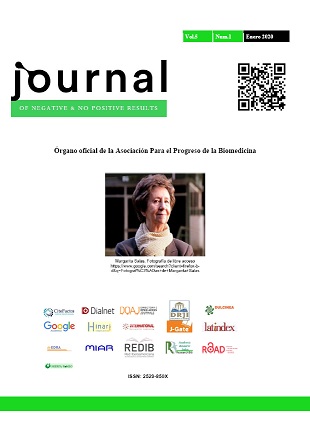Anticipatory medicine vs preventive medicine. How to create patients looking for health. (I) Statistics
DOI:
https://doi.org/10.19230/jonnpr.3254Abstract
-
Downloads
References
Skrabanek, P., (1994) Anticipatory medicine. En: The death of humane medicine and the rise of coercive healthism. (pp.31-37). Suffolk. England. Social Affairs Unit (Ed.).
Keys A, Aravanis C, Blackburn H, van Buchem FSP, Buzina R, Djordjevic BS, …Toshima H.: (1993) The seven countries study. A scientific adventure in cardiovascular disease epidemiology. Kromhout D, Menotti A, and Blackburn H. (Eds.). Marjan Nijssen-Kramer, Studio RIVM, Bilthoven, The Netherlands. ISBN 90-6960-048-x
Blackburn H. (1999). On the Trail of Heart Attacks in Seven Countries. Epidemiology & Community Health School of Public Health. University of Minnesota. Doi: https://sph.umn.edu/site/docs/epi/SPH%20Seven%20Countries%20Study.pdf
Shepherd J.: (1995) The West of Scotland Coronary Prevention Study. A Trial of Cholesterol Reduction in Scottish Men. Am J Cardiol; 76:113C-117C
Diamond D, Ravnskov U. (2015) How statistical deception created the appearance that statins are safe and effective in primary and secondary prevention of cardiovascular disease. Expert Rev. Clin. Pharmacol. 1–10. doi: 10.1586/17512433.2015.1012494
Ridker PM, Danielson E, Fonseca FA, et al. (2008) Rosuvastatin to prevent vascular events in men and women with elevated C-reactive protein. N Engl J Med;359:2195-207.
Heart Protection Study Collaborative Group: (2011) Effects on 11-year mortality and morbidity of lowering LDL cholesterol with simvastatin for about 5 years in 20 536 highrisk individuals: a randomised controlled trial. Lancet;378: 2013–20 DOI:10.1016/S01406736(11)61125-2
Ravnskov U, Okuyama H, Sultan S.: (2017). Serious bias in 20 year follow-up study of statin trial. BMJ;359:j4906 doi: 10.1136/bmj.j4906
Wise J.: (2017) Long term study backs statins for patients with high LDL and no other risk factors BMJ;358:j4171 doi: 10.1136/bmj.j4171
Ford I, Murray H, McCowan C, Packard CJ.: (2016) Long-Term Safety and Efficacy of Lowering Low- density Lipoprotein Cholesterol With Statin Therapy. 20-Year Follow-Up of West of Scotland Coronary Prevention Study. Circulation;133:1073-1080. DOI: 10.1161/CIRCULATIONAHA.115.019014.
Ravnskov U, de Lorgeril M, Diamond DM, Hama R, Hamazaki T, Hammarskjöld B, … Sundberg R.: (2018) LDL-C does not cause cardiovascular disease: a comprehensive review of the current literature, Expert Review of Clinical Pharmacology, 11:10, 959-970, DOI: 10.1080/17512433.2018.1519391
Collins R, Reith C, Emberson J, et al. (2016). Interpretation of the evidence for the efficacy and safety of statin therapy. Lancet;388: 2532–2561.
Silverman MG, Ference BA, Im K, et al. (2016) Association between lowering LDL-C and cardiovascular risk reduction among different therapeutic interventions: systematic review and meta-analysis. JAMA;316:1289–1297
Ference BA, Ginsberg HN, Graham I, et al. (2017) Low-density lipoproteins cause atherosclerotic cardiovascular disease. 1. Evidence from genetic, epidemiologic, and clinical studies. A consensus statement from the European atherosclerosis society consensus panel. Eur Heart J.38:2459–2472.
Schulz KF, Altman DG, Moher D. (CONSORT): (2010). Statement: updated guidelines for reporting parallel group randomised trials, BMJ;340:c332. doi: https://doi.org/10.1136/bmj.c332
Ravnskov U, Rosch PJ, McCully KS. (2012) The statin-low cholesterol-cancer conundrum.QJM;105:383-388
Abbasi J. (2019) New Cholesterol Guidelines Personalize Risk and Add Treatments. JAMA.; 321 (8): 731-732. doi:10.1001/jama.2018.21019
ASCVD Risk Estimator Plus. ACC. http://tools.acc.org/ASCVD-Risk-Estimators/#!/calculate/estimate/
White, L.: (1975) 'How to improve the public's health', New England Journal of Medicine, 293, pp. 113-11 A.
Skrabanek, P., (1994) Unhealthy obsession with health. En: The death of humane medicine and the rise of coercive healthism. (pp.37-41). Suffolk. England. Social Affairs Unit (Ed.).
Thomas, L. (1975). “Notes of a biology-watcher. The health-care system”, New England Journal of Medicine, 293, pp. 1245-1246.
Illich, I. (1975) Yatrogenesis Clínica. En: Némesis Médica. La expropiación de la salud. (pp.26-27) Barral (ed.)
Published
Issue
Section
License
All accepted originals remain the property of JONNPR. In the event of publication, the authors exclusively transfer their rights of reproduction, distribution, translation and public communication (by any sound, audiovisual or electronic medium or format) of their work. To do so, the authors shall sign a letter transferring these rights when sending the paper via the online manuscript management system.
The articles published in the journal are freely used under the terms of the Creative Commons BY NC SA license, therefore.
You are free to:
Share — copy and redistribute the material in any medium or format
Adapt — remix, transform, and build upon the material
The licensor cannot revoke these freedoms as long as you follow the license terms.
Under the following terms:
Attribution — You must give appropriate credit, provide a link to the license, and indicate if changes were made. You may do so in any reasonable manner, but not in any way that suggests the licensor endorses you or your use.
NonCommercial — You may not use the material for commercial purposes.
ShareAlike — If you remix, transform, or build upon the material, you must distribute your contributions under the same license as the original.
No additional restrictions — You may not apply legal terms or technological measures that legally restrict others from doing anything the license permits.

This work is licensed under a Creative Commons Attribution-NonCommercial-ShareAlike 4.0 International License

























